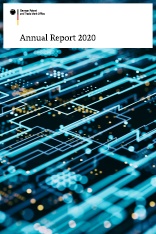Content
DPMA Annual Report 2020: innovation trends in automotive technology and digitisation
The coronavirus pandemic left its mark on the annual figures of the German Patent and Trade Mark Office – DPMA President: Despite the pandemic, there are also bright spots
Press release of 11 August 2021
Munich. Which technologies are currently developing particularly fast? How has the coronavirus pandemic affected innovation activity? And how does the German Patent and Trade Mark Office (DPMA) help innovative companies to protect their intellectual property? In its Annual Report 2020, which is available online as of today, the DPMA provides information on current IP trends for patents, utility models, trade marks and designs – and gives useful information on the function of IP rights and how to apply for them. "We, too, felt the effects of the coronavirus pandemic in the past year," said DPMA President Cornelia Rudloff-Schäffer. "However, besides unpleasant consequences, there are also bright spots, which make me optimistic." Although the total number of patent applications fell in comparison to the previous year, the number of inventions filed in individual cutting-edge fields of technology was significantly higher, for example in computer technology (+17.6%) and medical technology (+10.1%). Furthermore, there was a real boom in the trade mark sector, which saw a 13.5% increase in applications.
From the internal combustion engine to e-mobility: current analysis of automotive drive technologies
In the Annual Report, the DPMA also publishes a new analysis on the innovative activity in automotive drive technologies. There is a clear trend away from the internal combustion engine and towards e-mobility: While 15.0% fewer patent applications effective in Germany for internal combustion engines were published in 2020, compared to the previous year, there was a marked increase in the figures for electric drives (+7.8%) and batteries (+20.1%). Only the figures for fuel cells also declined compared to the previous year (-21.0%) – however, the figures in absolute terms in this field are significantly lower than, for example, for batteries. German applicants are at the top in all fields. The analysis includes applications published by the DPMA and the European Patent Office in 2020. Applications are usually published 18 months after filing.
Another analysis shows the immensely dynamic innovation activity in the field of digitisation. In the field of “digital communication”, which includes inventions for the new 5G standard, the number of published patent applications effective in Germany doubled over the past ten years to almost 15,000 in 2020. The activity in the field of “computer technology”, which also covers applications related to artificial intelligence, is almost equally dynamic.
In addition to technology trends, the DPMA’s Annual Report again contains a lot of statistical data – for example, the ranking of the German Länder in the various IP areas and the ranking of the top companies in terms of applications filed. The report also offers exciting stories, for example about strong trade marks from eastern Germany and about intellectual property rights relating to the guitar virtuoso Jimi Hendrix, whose 50th anniversary of death was in 2020.
As of now, the Annual Report 2020 can be downloaded from the DPMA website. The printed version will be available from the Press and Public Relations office from mid-June.
The German Patent and Trade Mark Office
Inventiveness and creativity need effective protection. The DPMA is the German centre of expertise for all intellectual property rights – patents, utility models, trade marks and designs. As the largest national patent office in Europe and the fifth largest national patent office in the world, our office stands for the future of Germany as a country of inventors in a globalised economy. Its staff of just under 2,800 at three locations – Munich, Jena and Berlin – provide services to inventors and companies. They implement federal innovation strategies and develop the national, European and international IP systems further.
Last updated: 11 August 2021


Not only protecting innovations
Social Media